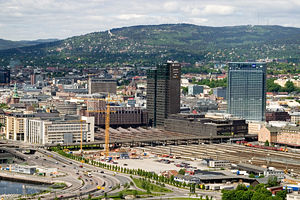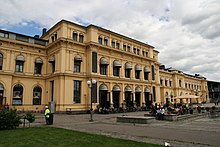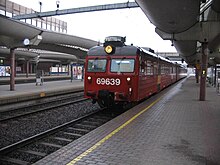
The Norwegian railway system comprises 4,109 km of 1,435 mm track of which 2,644 km is electrified and 274 km double track. There are 697 tunnels and 2,760 bridges.

Vygruppen, branded as Vy, formerly the Norwegian State Railways, is a government-owned railway company which operates most passenger train services and many bus services in Norway. The company is owned by the Norwegian Ministry of Transport. Its sub-brands include Vy Buss coach services, CargoNet freight trains and the Swedish train transport company Tågkompaniet. In 2009, NSB carried 52 million train passengers and 104 million bus passengers. On 24 April 2019, passenger train and bus services were rebranded as Vy.

The Bergen Line or the Bergen Railway, is a 371-kilometre (231 mi) long scenic standard gauge railway line between Bergen and Hønefoss, Norway. The name is often applied for the entire route from Bergen via Drammen to Oslo, where the passenger trains go, a distance of 496 kilometres (308 mi). It is the highest mainline railway line in Northern Europe, crossing the Hardangervidda plateau at 1,237 metres (4,058 ft) above sea level.

The Vestfold Line is a 137.79-kilometer (85.62 mi) railway line which runs between Drammen and Eidanger in Norway. The line connects to the Drammen Line at the northern terminus at Drammen Station and continues as the Bratsberg Line past Skien Station. The line is exclusively used for passenger trains, which are provided by Vy, which connect northwards to Oslo and south-westwards to Grenland. The 13-kilometer (8.1 mi) section from Eidanger to Skien is often colloquially included in the Vestfold Line.The standard gauge line is electrified at 15 kV 16.7 Hz AC and has twelve remaining stations. The Vestfold Line runs through the coastal region of Vestfold and serves major towns including Holmestrand, Tønsberg, Sandefjord and Larvik, as well as Sandefjord Airport, Torp.

The Østfold Line is a 170-kilometer (110 mi) railway line which runs from Oslo through the western parts of Follo and Østfold to Kornsjø in Norway. It continues through Sweden as the Norway/Vänern Line. The northern half is double track and the entire line is electrified. It serves a combination of commuter, regional and freight trains and is the main rail corridor in the south of Norway. The Follo Line runs parallel to the Østfold Line in tunnel. The Eastern Østfold Line branches off at Ski Station and runs 79 kilometers (49 mi) before rejoining at Sarpsborg Station.

The Eastern Østfold Line is a 79-kilometer (49 mi) railway line which runs between Ski and Sarpsborg. It follows a more eastern route than the Østfold Line, with which it adjoins at both Ski Station and Sarpsborg Station, serving the Indre Østfold district. The line is single track and electrified. The Eastern Line serves the hourly R22 services of the Oslo Commuter Rail, operated by Vy. There is no regular traffic south of Rakkestad Station, although the line can be used for freight trains when the Western Line is closed.

Nationaltheatret Station is an underground railway station on the Drammen Line serving Vika and the central business district of Oslo, Norway. It is the second-busiest railway station in Norway, behind Oslo Central Station (Oslo S), from which Nationaltheatret is 1.4 kilometers (0.9 mi) away. Owned and operated by Bane NOR, Nationaltheatret serves regional services to the Vestfold Line and the Oslo Commuter Rail operated by Vy, intercity services on the Sørland Line operated by Go-Ahead Norge, and the Airport Express Train.
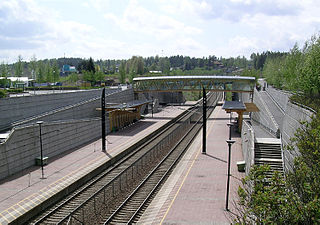
The Gardermoen Line is a high-speed railway line between Oslo and Eidsvoll, Norway, running past Lillestrøm and Oslo Airport, Gardermoen. The line is 64 kilometres (40 mi) long and replaced the older Hoved Line as the main line north-east of Oslo. The older Hoved Line now handles commuter and freight traffic, while the Gardermoen Line handles high-speed passenger trains and freight trains laden with jet fuel for the airport. Both lines are owned by Bane NOR.

The Oslo Tunnel is a 3,632-metre (2.257 mi), double-track, railway tunnel which runs between Olav Kyrres plass and Oslo Central Station (Oslo S) in Oslo, Norway. The tunnel constitutes the easternmost section of the Drammen Line and runs below the central business district of Oslo. It features the four-track Nationaltheatret Station, Norway's second-busiest railway station, where the Oslo Tunnels lies directly beneath the Common Tunnel of the Oslo Metro. At Frogner, the Elisenberg Station was built, but has never been used. The tunnel is the busiest section of railway line in Norway and serves all west-bound trains from Oslo, including many services of the Oslo Commuter Rail and the Airport Express Train.

Vy Gjøvikbanen AS is a Norwegian railway company that operates the passenger train service on the Gjøvik Line. A subsidiary of the state-owned Vy, it operates a fleet of nine Class 69g three-car electric multiple units. NSB Gjøvikbanen provides two different services: the Skøyen – Oslo S – Jaren service is part of the Oslo Commuter Rail; while Oslo S – Gjøvik is a regional service, with only limited stops on the route until Grua. Departures are each 40 minutes, with every third train running to Gjøvik.

Skøyen Station is a railway station located at Skøyen in Oslo, Norway. It is situated on the Drammen Line, 4.36 kilometers (2.71 mi) from Oslo Central Station. It is served by regional trains and the Oslo Commuter Rail, operated by Vy, as well as by the Airport Express Train. The station is elevated and has two island platforms and four tracks.

Lysaker Station is a railway station on the Drammen Line and Asker Line situated at Lysaker in Bærum, Norway. Located 7.00 kilometers (4.35 mi) from Oslo Central Station, Lysaker is served by a mix of Vy express, regional and Oslo Commuter Rail trains, as well as Flytoget. The station is elevated and features two island platforms with four tracks. It's the terminus of the Asker Line.

Oslo Airport Station, also known as Gardermoen Station, is a railway station located in the airport terminal building of Oslo Airport, Gardermoen in Norway. Located on the Gardermoen Line, it is served by the Airport Express Trains, express trains to Trondheim and Oslo, regional trains to Lillehammer and Skien and commuter trains to Eidsvoll and Kongsberg.

Ruter AS is the public transport authority for Oslo and Akershus counties in Norway. Formally a limited company – 60% of its shares are owned by the Oslo county municipality and 40% by that of Viken – it is responsible for the administration, funding, and marketing of public transport in the two counties, including buses, the Oslo Metro, Oslo Trams, and ferry services. Ruter also holds agreements with Entur concerning the regulation of fares on local and regional train services operated within the two counties.

Oslo Commuter Rail is a commuter rail centered in Oslo, Norway, connecting the capital to six counties in Eastern Norway. The system is operated by Vy and its subsidiary Vy Gjøvikbanen, using Class 69 and Class 72 electric multiple units (EMU). The network spans eight routes and 128 stations, with Oslo Central Station (Oslo S) as the central hub. The trains run on 553 kilometers (344 mi) of electrified mainline railway owned by the Bane NOR. Deficits are financed by the Norwegian Ministry of Transport, although the network also has a ticketing cooperation with Ruter, the public transport authority in Oslo and Akershus. The network is the longest commuter rail network in the Nordic countries, and among top ten in Europe.

Nationaltheatret is an underground metro station and tram stop serving Vika and the city center of Oslo, Norway. It is located on the Common Tunnel of the Oslo Metro and on the Briskeby Line of the Oslo Tramway. Also located at the same place is Nationaltheatret Station of the Drammen Line. The station is served by all five lines of the metro, and lines 11 and 13 of the tramway. In addition, several bus services call at the station. It is named for the National Theatre located nearby.

Stabekk Station is a railway station of the Drammen Line situated at Stabekk in Bærum, Norway. Located 8.99 kilometers (5.59 mi) from Oslo Central Station, it is served by line L1, L2, L2x and L21 of the Oslo Commuter Rail and by Flytoget - the express train to Oslo Airport. It is located in a primarily residential area and has four regular hourly services operated by Vy. The station features an island platform accessible from the station building on the south side.
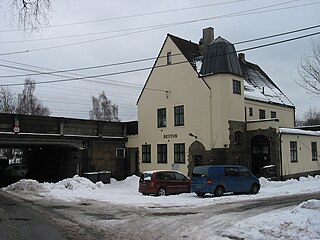
Bestun Station was a railway station situated at Bestum of the Ullern area of Oslo, Norway, on the Drammen Line. The station, located 4.31 kilometers (2.68 mi) from Oslo West Station (Oslo V), was served by Oslo Commuter Rail trains of the Norwegian State Railways.

The Hurum Line was a proposed railway line which would have connected Røyken and Hurum in Asker municipality, Norway. Launched during the Oslo Airport location controversy during the second half of the 1980s, its main purpose was to act as an airport rail link to serve the proposed national airport on Hurumlandet. The main proposal for the line called for a 14-kilometer (8.7 mi) section of double track which would branch from the Spikkestad Line at Hallenskog. Construction of the Hurum Line would have seen 7 kilometers (4.3 mi) of the Spikkestad Line upgraded to double track as well as upgrades to the Drammen Line. The distance from Hurum to Oslo is 45 kilometers (28 mi), with travel time estimated at 35 minutes.
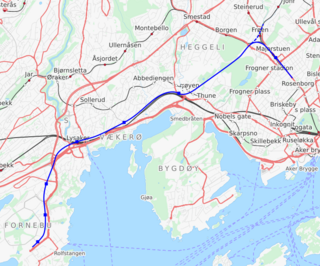
The Fornebu Line is an under construction rail line which will serve the peninsula of Fornebu in Bærum, Norway. The line is under construction and the transit agency Ruter is working towards connecting it to the Oslo Metro. The line has at various stages been proposed as an automated people mover, tram-train, tramway, light rail, stadtbahn, rapid transit, bus rapid transit and commuter rail, with the rapid transit option being selected as the final proposal. The metro line will start at Majorstuen Station and will run entirely in a tunnel for 8,150 meters (26,740 ft). The line will have six stations, at Skøyen, Vækerø, Lysaker, Telenor Arena, Flytårnet and Fornebu Senter. A depot will be built at Fornebu and the line will connect to the metro's Common Tunnel at Majorstuen.
